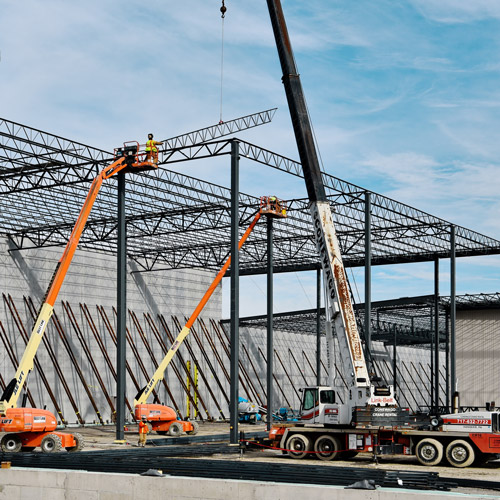
There’s no such thing as a typical week for Nancy Weinstein. On a calm day, she spends her first few hours at work checking items off her to-do list, but by 9:00 a.m., unplanned emergencies begin. Examples might include, but are not limited to, a network failure, a catastrophic weather event, or a driver accidentally steering through the side of a building. Whatever it is, Weinstein says, “no two days are ever alike.”
This unpredictability was what initially drew Weinstein to a facility-management career. After majoring in accounting and finance at Suffolk University, she took a position in the construction department at Equity Office, a commercial real estate firm, and was directed to balance and close the budgets on each of its tenant build-outs. Although her core focus was on the financial side, Weinstein was soon presented with expanded opportunities to work on minor tenant-improvement build-outs, and she enjoyed the new challenges that were presented to her. “Every day begins with a new puzzle piece,” she says. “My job is to figure out what is the most effective and efficient way to fit the piece into the company’s overall accomplishments or strategies.”
“The job of a facility manager is never done,” says Jeff Robbins, director of commercial pest marketing at Rentokil North America. “It takes a special person with good organizational skills, patience, and perseverance to navigate the daily challenges and demands. We salute Nancy and her professionalism.”
When challenged with solving puzzles, Weinstein collaborates closely with all departments across her organization. “My main role as a senior facility manager is to bring all necessary key stakeholders together to create process efficiencies,” she says.
Leasing, Transactions, and Legal
A property lease is long and typically does not clearly state facility management’s responsibilities. In spite of this, Weinstein needs to know things such as who clears the snow or fixes the roof. “The facility department is only focused on about three out of a lease’s 100 pages, but those three are very critical to us,” Weinstein says. “No lease is ever signed until facilities has reviewed it and provided their feedback.”
A facility department deals with hundreds of vendor contracts each year, but one of the largest involves snow and landscaping. In 2014, record-breaking snowfall hit the northeastern United States. Every day, for more than ten weeks, Weinstein’s day consisted of determining which properties would not be able to operate within business hours, clearing hundreds of parking lots, and coordinating the shoveling of snow from many roofs because of the weight of the snow. “By the time we would clean up from one event,” Weinstein says, “the next storm was on its way.”
When negotiating snow-removal contracts, Weinstein has learned, it’s important to include a presalting requirement. A failure to presalt leads to ice buildup, which results in many slip and falls. “Those accidents can quickly snowball into an exorbitant number of slip-and-fall insurance claims that we continuously respond to throughout the summer,” Weinstein says.
Project Management
Once a lease has been reviewed and signed, the project-management team produces drawings for all build-outs or renovations. “That engagement between the project-management and facility teams is very important and needs to be strong,” Weinstein says. “There are often times the teams don’t agree on what is best for a space, but since there is no I in team, we work together to compromise on the best solution.”
The project-management team’s view can be limited to a given location whereas Weinstein considers each location as part of the wider real estate portfolio. Even the smallest detail, such as which light bulb to purchase, must remain consistent across the network. Buying a nonstandard light fixture may save the project team money initially, but it requires the facility team to purchase multiple types of light bulbs, thus increasing overall costs. “Even though a project manager sees the build-out from beginning to end,” Weinstein says, “on opening day, the keys are handed over to facilities to manage going forward.”
Space Planning
Whether employees are moving a mile or relocating across state lines, Weinstein works closely with the space-planning department to coordinate the moves. “Even though the space-planning manager will take the lead in the actual coordination of moving individuals, each move always requires a facility person to be involved in the process,” Weinstein says.
The facility department carries the responsibility of coordinating the purging or archiving of old documents, returning old electronics to the IT department, and setting up new desks. The space-planning team has the responsibilities of determining where employees will relocate to and makes sure they get there, Weinstein explains. “Once that’s completed, then it’s facilities’ job to make sure that they’re comfortable at that location,” she says.
IT
Like facilities, the IT department has its physical assets to account for. “They deal with equipment, and we deal with the areas surrounding the equipment,” Weinstein says. In some cases, the distinction between who owns responsibility of the equipment and surroundings is clear—for example, when installing a credit card pin pad. “The pad itself—that’s an IT piece of equipment,” Weinstein says. “But providing the mount and installing it to the counter is the responsibility of the facility team.”
When addressing larger infrastructural issues, both departments need to be involved. In the event of a network outage, for example, the business continually reaches out to the facility team to investigate the electrical system and the IT lead manager for any server issues. Most team members are often not located in the same office, so being able to quickly communicate is vital.
Security
Some of Weinstein’s closest cross-functional collaboration occurs with the security department. The security and facility teams work together daily to ensure that customers and employees are accessing safe environments. Anticipating potential security issues is particularly important for remote locations. In the event of protests, rallies, or other large gatherings where there might be anticipated security threats, Weinstein works with security to inform local managers. “When working remotely, you need to understand who the key players are and how to solve a problem rather quickly,” Weinstein says. “If your home office is in Boston, you do not know what’s happening in downtown New York.”
Photo: Jake Forg


